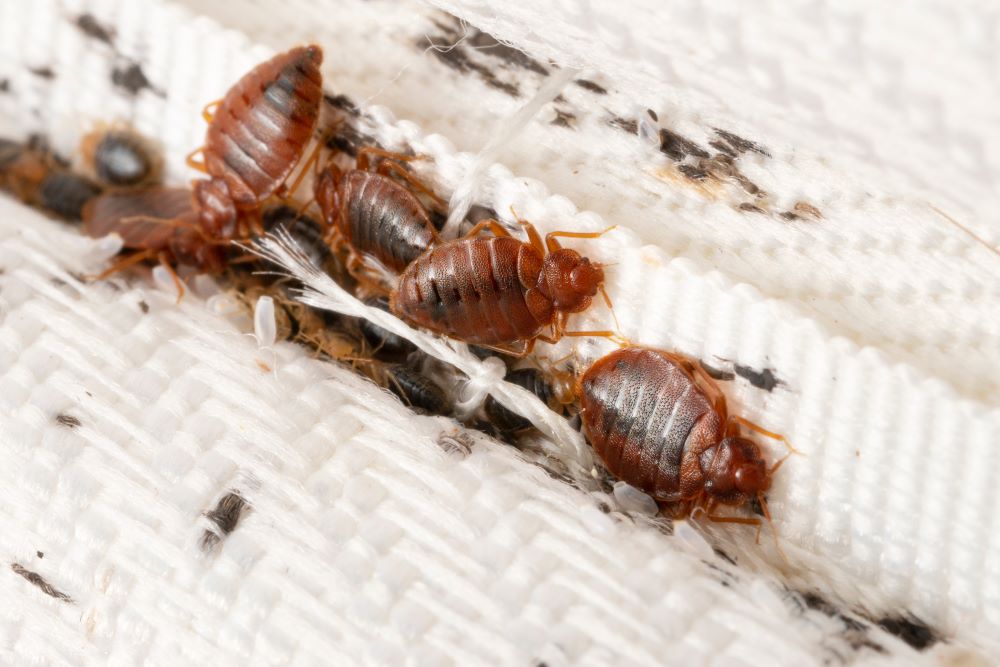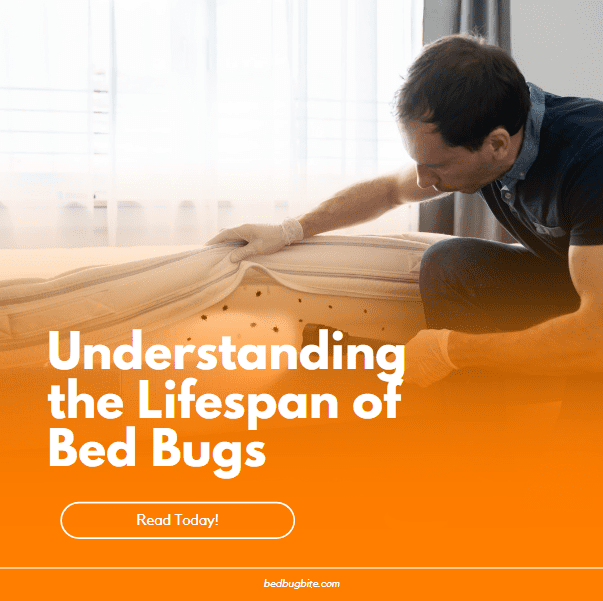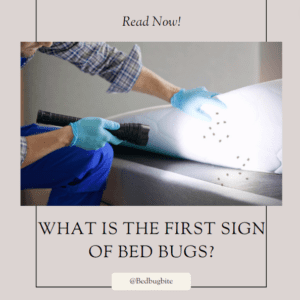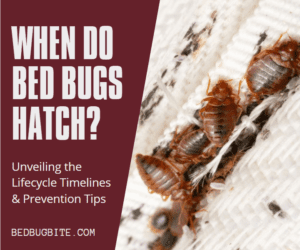Introduction to Bed Bug Life Cycles
Welcome to our comprehensive guide on understanding the lifespan and eventual demise of bed bugs. A topic of significant interest and concern for many homeowners and pest control professionals alike. In this introduction, we embark on a journey to unravel the mysteries of bed bug life cycles, shedding light on the different stages from eggs to nymphs and finally, to adults. Recognizing these life stages is not just academic. It’s a critical step in devising effective strategies to combat these resilient pests. …Click Here to Read more Fascinating Bed Bug Articles!

Bed bugs, known scientifically as Cimex lectularius, are not just a nuisance. They are skilled survivors, having coexisted with humans for thousands of years. Their lifecycle is fascinating yet troubling, as it highlights their adaptability and resilience in various environments. Understanding the lifecycle of bed bugs is paramount for effective pest control. It equips us with the knowledge needed to interrupt their breeding cycle, making our interventions more targeted and effective.
Insights into Their Survival and Demise
One pivotal aspect of managing bed bug infestations is recognizing that these creatures are not invincible. Various factors influence their longevity and survival rates, from the temperature of their environment to their exposure to pesticides. By delving into these elements, we gain insights into how to create conditions that are less hospitable for bed bugs. Thereby reducing their chances of survival and reproduction.
To ensure our readers have access to the most accurate and detailed information, we draw upon reputable sources such as the Environmental Protection Agency (EPA), which offers a wealth of knowledge on bed bug biology and control measures. For instance, the EPA’s insights into bed bug life stages and recommended control strategies provide a solid foundation for understanding how to tackle these pests effectively.
As we proceed, remember that knowledge is power. By fully understanding the lifecycle of bed bugs and the factors that influence their survival, you are better equipped to protect your home and family from these unwelcome guests. Let’s continue our journey by exploring the natural lifespan of bed bugs. Diving deeper into how long these pests can live under ideal conditions, and what we can do to disrupt their life cycles and prevent infestations.
The Natural Lifespan of Bed Bugs
Continuing our exploration into the enigmatic world of bed bugs, we delve into the natural lifespan of these persistent pests and the conditions that favor their survival. Under optimal conditions, bed bugs can exhibit quite the tenacity for life. Which underscores the importance of understanding their longevity for effective pest management.
How Long Bed Bugs Live Under Ideal Conditions
In an environment that bed bugs find conducive—characterized by ample access to human blood for feeding, moderate temperatures, and adequate hiding spots—these insects can live surprisingly long. A typical bed bug, in its lifetime, can survive for about 10 months to a year. However, with regular feeding and ideal conditions, some can even push beyond the year mark. This longevity allows them ample time to reproduce multiple times, exacerbating infestations if not promptly addressed.
Factors That Influence Bed Bug Longevity
Several key factors play a crucial role in determining how long a bed bug lives, making it essential to understand and manipulate these conditions to our advantage.
- Feeding opportunities: Bed bugs are primarily nocturnal and feed on human blood. The frequency and availability of feeding opportunities directly impact their health and reproductive cycles. Extended periods without feeding can significantly reduce their lifespan, although they are known to survive several months in a dormant state without a blood meal.
- Environmental temperature: Temperature is a critical determinant of bed bug survival. They thrive in temperatures that are comfortable for humans, generally between 70°F to 80°F (21°C to 27°C). Deviations from this range, especially to the extremes, can adversely affect their longevity and reproductive capacity.
- Humidity levels: Bed bugs require a certain level of humidity to survive, preferably between 70% to 80%. Low humidity levels can lead to dehydration, while too high humidity can foster mold growth in their habitats, negatively affecting their survival.
By addressing these factors in our pest control strategies—such as manipulating temperature and humidity levels in infested areas and limiting feeding opportunities—we can create less favorable conditions for bed bugs to thrive and reproduce. This approach not only challenges their survival but also enhances the effectiveness of eradication efforts. Bringing us one step closer to a bed bug-free environment.
Temperature: A Crucial Factor in Bed Bug Survival
Temperature stands out as a pivotal factor in the survival of bed bugs, playing a crucial role in both their development and mortality. Understanding how temperature impacts these pests is key to leveraging it against them in pest control strategies. By exploring the effects of extreme temperatures, we can uncover effective methods to reduce bed bug populations and prevent their spread.
How Cold Temperatures Affect Bed Bugs
Bed bugs, despite their resilience, are not well-equipped to withstand extremely cold environments. Research indicates that exposing bed bugs to temperatures below 0°F (-18°C) for at least four days can effectively kill them, including their eggs. This vulnerability to cold can be utilized in pest control by placing infested items in a freezer set to the appropriate temperature. Providing a non-chemical method for dealing with small-scale infestations or treating sensitive items that cannot be exposed to heat or pesticides.
The Effectiveness of Heat Treatment
Conversely, bed bugs are also susceptible to high temperatures, making heat treatment a highly effective method for exterminating these pests. Professionals often employ this strategy by raising the temperature in an infested area to at least 118°F (48°C) for 90 minutes or more. A condition under which bed bugs cannot survive. This method has the advantage of penetrating hard-to-reach places, ensuring a more comprehensive eradication than traditional chemical treatments. Furthermore, heat treatment is a safe, eco-friendly option, posing no risk of chemical residue or harm to non-target species.
The impact of temperature on bed bugs underscores the importance of integrating thermal management into pest control strategies. By understanding and manipulating the conditions that affect bed bug survival, homeowners and professionals alike can target these pests more effectively. Reducing reliance on chemical treatments and fostering a safer, more sustainable approach to bed bug management.
Chemical Pesticides: A Double-Edged Sword
The battle against bed bugs often involves the strategic use of chemical pesticides, which, while effective, come with their own set of challenges and considerations. Understanding the nuanced relationship between bed bugs and chemical treatments is vital for anyone looking to manage an infestation effectively. By examining the most commonly used pesticides, their impact, and the emerging issues of resistance, we can navigate the complexities of chemical pest control with greater precision.
Commonly Used Pesticides and Their Impact on Bed Bugs
Chemical pesticides have long been a cornerstone in the fight against bed bugs. Products containing pyrethroids, pyrethrins, and neonicotinoids are among the most widely used due to their effectiveness in killing these pests on contact. However, their success is not without limitations. The efficacy of chemical treatments depends on direct application to the bed bugs or their habitats. A task complicated by the pests’ ability to hide in hard-to-reach places. Moreover, the indiscriminate use of chemicals raises concerns about human and pet safety. Necessitating careful application and adherence to safety guidelines.
Resistance Issues and the Search for Effective Solutions
One of the most significant hurdles in chemical pest control is the rapid development of resistance among bed bug populations. Over time, bed bugs have evolved to withstand substances that once killed them easily, rendering some pesticides ineffective. This resistance issue prompts ongoing research into newer, more effective chemical formulations and the exploration of integrated pest management strategies that combine chemical treatments with other methods, such as heat treatment and mechanical removal, to maintain effectiveness.
Safety Concerns and Best Practices for Application
While chemical pesticides play a crucial role in bed bug management, their use comes with important safety considerations. It’s crucial to select EPA-registered pesticides specifically labeled for bed bugs and follow the product instructions meticulously. Proper ventilation, the use of protective clothing, and avoiding application on mattresses or furniture directly in contact with skin can minimize health risks. Moreover, involving professional exterminators who understand the safe and effective use of these chemicals can ensure that bed bug treatments are not only successful but also safe for households.
In navigating the challenges and complexities of using chemical pesticides for bed bug control, it becomes clear that an informed, cautious approach is essential. Understanding the nuances of chemical treatments. From the selection of the right products to the implementation of safe application practices, can significantly enhance the effectiveness of pest management strategies while safeguarding human health and the environment.
Natural Predators and Biological Control
The battle against bed bugs isn’t fought with chemicals alone. Nature itself offers a host of solutions in the form of natural predators and biological control methods. Understanding the role these natural enemies play in controlling bed bug populations can provide us with insight into alternative management strategies that complement traditional pest control methods, offering a holistic approach to tackling these persistent pests.
Exploring Natural Enemies of Bed Bugs in the Wild
In the natural world, bed bugs have several predators that help keep their populations in check. Creatures such as spiders, cockroaches, centipedes, and even some species of ants are known to prey on bed bugs. While the idea of introducing these predators into a home environment is impractical and not advisable. Recognizing the role of natural predation can inspire the development of bio-inspired pest control strategies. This knowledge underscores the importance of maintaining a balanced ecosystem, where natural predators can help manage pest populations.
The Role of Biological Control Methods in Managing Bed Bug Populations
Biological control methods involve the use of living organisms to reduce or eliminate pest populations. In the case of bed bugs, research into biological control is still in its infancy. With scientists exploring potential uses of fungi, bacteria, and even parasitic wasps that specifically target bed bugs without posing risks to humans. These approaches aim to offer targeted, environmentally friendly alternatives to chemical pesticides. Reducing the reliance on harmful substances and minimizing the impact on non-target species and the broader environment.
Integrating natural predators and biological control methods into bed bug management strategies represents an innovative and sustainable approach to pest control. By harnessing the power of nature, we can develop more effective, less harmful ways to combat bed bug infestations. This not only aligns with broader environmental goals but also addresses the growing issue of pesticide resistance. Offering hope for more resilient and adaptable pest management solutions in the future.
Home Remedies and DIY Solutions

The quest to control bed bugs extends into the realm of home remedies and DIY solutions. Where simplicity and accessibility play key roles. These methods, often passed down through generations or shared online, offer a first line of defense for many looking to manage minor infestations or prevent the spread of bed bugs. While not all home remedies are equally effective, understanding their potential and limitations can empower homeowners to take proactive steps in bed bug management.
Popular Home Remedies and Their Effectiveness
Among the myriad of home remedies touted for bed bug control, a few stand out for their relative effectiveness. Diatomaceous earth, a naturally occurring powder, is known for its ability to dehydrate and kill bed bugs when they come into contact with it. Similarly, vacuuming can physically remove bed bugs from surfaces, and sealing cracks and crevices can prevent their entry and spread. Essential oils, such as tea tree oil, have also been cited for their repellent properties. Though their efficacy in eliminating bed bugs is less clear. While these methods can be part of a comprehensive pest control strategy, they are typically most effective when combined with professional treatments.
Limitations and Precautions When Using DIY Methods
It’s crucial to approach home remedies with a healthy dose of skepticism and caution. Not all methods are backed by scientific evidence, and some can even pose risks if not used correctly. For instance, the misuse of essential oils can lead to skin irritation or other health issues, and over-reliance on DIY solutions may allow infestations to grow unchecked. Moreover, some remedies, like the application of heat or cold, require precise control to be effective and safe, highlighting the importance of professional guidance.
In the landscape of bed bug management, home remedies and DIY solutions occupy a unique space. They offer a glimpse into the ingenuity and resourcefulness of individuals facing pest challenges. However, their true value lies in their ability to complement professional pest control efforts, providing a multi-faceted approach to managing bed bug infestations. By understanding the strengths and limitations of these methods, homeowners can make informed decisions. Taking proactive steps towards a bed bug-free environment while awaiting professional intervention.
Prevention and Early Detection
In the world of pest management, prevention and early detection are key elements in the fight against bed bugs. These strategies not only help in avoiding infestations but also significantly reduce the complexity and cost of treatment should bed bugs make their unwelcome appearance. By focusing on prevention and staying vigilant for early signs of bed bugs, individuals can safeguard their homes and belongings from these persistent pests.
Tips for Preventing Bed Bug Infestations
Preventing bed bug infestations requires a combination of diligence and proactive measures. Regularly inspecting second-hand furniture before bringing it into your home can prevent unintentionally introducing bed bugs into your space. Encasing mattresses and box springs with protective covers designed to keep out bed bugs is another effective measure. Additionally, reducing clutter in your home eliminates potential hiding spots for bed bugs. Making it easier to spot and address any issues early on. Travelers should also be mindful of bed bugs by inspecting hotel rooms and managing luggage to avoid bringing these pests home.
Signs of Bed Bugs to Watch Out For
Early detection of bed bugs hinges on recognizing the signs of their presence. Small, rusty spots on bedding or mattresses can indicate bed bug droppings. While tiny, white eggshells or shed skins in the vicinity of your bed are signs of a growing infestation. Additionally, waking up with itchy, red bites, particularly in a line or cluster, suggests bed bug activity. Prompt identification of these signs can lead to quicker intervention and easier management of the problem.
Early Detection Tools and Techniques
Leveraging tools and techniques for early detection can further enhance efforts to manage bed bug populations. Bed bug interceptors placed under bed and furniture legs can trap bed bugs attempting to climb up, serving as an early warning system. Regular vacuuming, especially along baseboards, bed frames, and other furniture, can help remove bed bugs before they establish a foothold. Employing these strategies as part of a routine can significantly reduce the likelihood of a full-blown bed bug infestation.
By prioritizing prevention and early detection, individuals can take significant strides in protecting their homes from bed bugs. These measures, both simple and more involved, build a defense system that reduces the risk of infestation and makes managing these pests more manageable. Engaging in these practices demonstrates a proactive approach to pest control. Emphasizing prevention over reaction and highlighting the importance of vigilance in maintaining a bed bug-free environment.
Conclusion: Integrating Knowledge for Effective Bed Bug Management
As we conclude our comprehensive journey through the lifecycle, vulnerabilities, and control measures of bed bugs, it’s clear that knowledge and proactive strategies are our best defenses against these persistent pests. Understanding the factors that influence bed bug survival and employing a multifaceted approach to prevention, detection, and eradication can significantly mitigate the impact of these insects on our lives. By integrating the insights and methods discussed, from leveraging temperature extremes to embracing natural predators and safe chemical treatments, we empower ourselves to tackle bed bug infestations more effectively and sustainably.
The Importance of a Comprehensive Approach to Bed Bug Control
No single method guarantees complete eradication of bed bugs due to their resilience and adaptability. Therefore, a comprehensive approach—combining thermal treatment, chemical solutions, natural deterrents, and vigilant prevention practices—proves to be the most effective strategy. Tailoring this approach to the specific conditions and severity of the infestation ensures that control measures are both efficient and effective, minimizing the disruption to our daily lives and the environment.
Encouragement for Ongoing Education and Professional Consultation
Continuous education on bed bug behavior, emerging control technologies, and resistance trends is crucial for staying ahead of these pests. Resources such as the Environmental Protection Agency (EPA) and the Centers for Disease Control and Prevention (CDC) offer valuable, up-to-date information on bed bug management. Furthermore, consulting with pest management professionals, who can offer customized solutions and advanced treatment options, enhances our ability to achieve lasting results in the battle against bed bugs.
In navigating the complexities of bed bug management, remember that vigilance, education, and adaptability are key. By staying informed about the latest research and advancements in pest control, employing a combination of proven strategies, and seeking professional guidance when necessary, we can maintain control over bed bug infestations, ensuring the health and comfort of our living environments. Together, armed with knowledge and the right tools, we stand a strong chance of keeping our homes bed bug-free.




